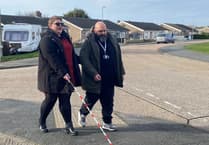It was good to enjoy a walk without high winds and the threat of rain.
Sixteen members set out for this walk of a little over seven miles in the rolling hills of mid-Devon. The walk was on a mix of fields, riverside paths and lanes and there was plenty of mud and still a little ice about so care was needed with the slippery terrain.
They set out from Coldridge, originally a Norman settlement, which was known as Coleridge until the early 20th century. According to Devon historian Risdon the village was named for the poor quality soil but it appeared in the Doomsday Book as Colridge which is thought to mean ‘the ridge where charcoal is made’. Crossing through fields they soon joined The Tarka Trail at Westacott Wood and continued walking beside the River Taw which rises high on the slopes of Dartmoor and flows down to the estuary at Barnstaple.
The walkers stopped briefly at the 12th century church of St Mary the Virgin in Brushford, one of the smallest churches in Devon, where the vicar very kindly allowed them inside to look around and to hear a little of the history of the building and its parishioners.
The church has Norman origins with the chancel dating back to the 14th century and the nave to the 15th century. The west tower was added during the following century, and the entire church rebuilt in 1876. The only surviving feature of the medieval church is the 12th century south doorway.
The tower was originally topped by a spire, but this burned down in 1693 after it was struck by lightning and was replaced with a peculiar cap hung with slate tiles.
The best historic feature of the church is the colourful late 15th century chancel screen. The Romans had a chain of forts along the western-most boundary of The Taw and the earthworks of one is still visible by the river at Brushford. Lead and silver for the Royal Mint was mined after 1491, but it remained mostly an agricultural area.
From Brushford Church, the group continued through fields and latterly along steep lanes to Nymet Rowland. The village takes part of its name from “Nymet”, the old name for the nearby River Yeo.
Some of the group went inside the 15th century St Bartholomew Church. Traces of the 12th century church remain in the south doorway.
Inside the church is a white sandstone lead-lined font, typically Norman. Henry VIII was anxious to establish himself as head of the church after the disestablishment of the Church of Rome, and an act of parliament was passed making it obligatory for every church to display its allegiance to the reigning monarch. The Royal Coat of Arms remains on one wall.
After leaving the village the walkers crossed up through steep fields back to Coldridge where they were made very welcome in the village hall and served hot drinks and delicious home-made cakes made by some of the ladies of the parish.
As ever, new walkers are always welcome. You should be suitably attired for all weather conditions, including sturdy footwear and bring a drink and a packed lunch.
Meet at the post office in George Street, Okehampton on Sundays ready to leave at 9.30am.
Members share cars so please be there in plenty of time so the group can leave promptly. Car drivers with spare seats are encouraged to meet at the post office to offer lifts to non-drivers.




